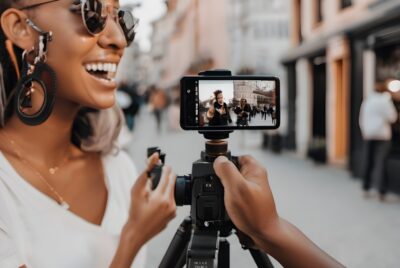Leading Lines Photography: Mastering the Art of Visual Direction
Ever looked at a photo and felt your eyes being pulled in a specific direction? That’s no accident—that’s the power of leading lines in photography. In this post, I’m diving deep into how you can harness this technique to give your photos depth, story, and serious visual punch. If you’re an enthusiast like me or just getting started, you’re about to unlock one of the most powerful composition tools in your creative toolkit.
What Are Leading Lines in Photography?
Leading lines are visual elements in a photo—like a road, a fence, or a river—that naturally guide the viewer’s eyes toward the subject or through the scene. They don’t just exist for decoration; they’re silent storytellers that add structure and intent to your composition.
>> Essential gear for great photography HERE <<
The Psychology Behind Leading Lines
Our brains love order. When we see a line in a photo, our eyes instinctively follow it. It’s a subconscious nudge, telling us, “Hey, look over here!” That’s why photos with strong leading lines often feel more immersive and engaging—they pull us in and keep us there.
Why Use Leading Lines in Your Shots?
Let me break it down a bit more…
Creating Depth and Dimension
Flat photos are forgettable. Leading lines create a sense of space and perspective, giving your image a three-dimensional feel. It’s like stepping into the frame rather than just looking at it.
Guiding the Viewer’s Eye
If you want someone to focus on your subject, leading lines are your secret weapon. They act like visual arrows, directing the viewer exactly where you want them to look.
Types of Leading Lines
Leading lines come in all shapes and directions. Here’s a look at the main ones:
Straight Lines
Roads, Fences, and Bridges
Think highways stretching into the horizon or fences dividing fields. These strong, straight elements add structure and formality to a composition.
Curved Lines
Rivers, Trails, and Pathways
Curved lines offer a softer, more natural feel. They gently guide the eye and add a sense of movement, often leading us on a visual journey through the frame.
Diagonal Lines
Dynamic Movement and Energy
Diagonals inject a sense of motion and tension. They’re bold and assertive, often used to create drama and excitement.
Converging Lines
Perspective and Focus
When two lines meet or appear to converge, they can lead the eye directly to your subject—think railway tracks or architectural corridors. They scream perspective.
Where to Find Leading Lines in Everyday Life
The world is full of them—you just have to start noticing.
Urban Landscapes
Sidewalks, crosswalks, building edges, power lines—cities are a playground for leading lines. Keep your eyes open and your camera ready.
Nature and Outdoor Settings
Hiking trails, rivers, rows of trees, mountain ridges—Mother Nature is a master of visual storytelling.
Architectural Details
Staircases, columns, arches, hallways—architecture offers strong geometric elements that are perfect for building dynamic compositions.
>> Essential gear for great photography HERE <<
How to Compose with Leading Lines
Once you spot them, it’s all about how you use them.
Positioning Your Camera
Low angles can make lines more dramatic, especially roads or rails. Experiment with different heights and angles to change the way lines interact with your subject.
Choosing the Right Lens
Wide-angle lenses exaggerate perspective and make lines stretch dramatically into the distance. Great for adding depth and drama.
Using Foreground and Background
Layer your scene. A line in the foreground can lead to a subject in the background, creating a sense of scale and narrative.
Creative Tips for Better Leading Line Photos
Let’s level up your shots:
Break the Rules (Strategically)
Rules are meant to be bent. Place your subject off-center. Make the line lead nowhere. The key is to be intentional—break the rule with a purpose.
Combine with Other Composition Techniques
Leading lines pair beautifully with the rule of thirds, symmetry, and framing. Stack your techniques for maximum visual impact.
Convert to Black and White
Stripping away color can emphasize shape, contrast, and… you guessed it—lines. Try it. You’ll be amazed at how powerful your compositions become.
Common Mistakes and How to Avoid Them
Been there, done that. Here’s what to watch for:
Overusing or Forcing the Line
Not every photo needs a leading line. Don’t cram one in just because you can. If it doesn’t serve the story, skip it.
Ignoring the Subject
Remember: the line should lead to something. A stunning line that goes nowhere or leads to a dull spot won’t hold attention for long.
Post-Processing Ideas to Enhance Leading Lines
Let’s polish those photos to perfection.
Enhance Contrast and Clarity
Make those lines pop. Boost contrast, sharpen the edges, or add a vignette to subtly draw focus where you want it.
Use Cropping to Strengthen the Line
Sometimes, cropping in a little tighter can enhance the power of a line. Don’t be afraid to adjust the frame after the fact.
Conclusion
Leading lines are more than just a fancy term—they’re one of the most effective tools you can use to create powerful, engaging photos. Whether you’re shooting a cityscape, a quiet forest path, or a dramatic architectural detail, leading lines help guide the eye, tell a story, and add visual depth. Once you start seeing them, you won’t stop—and your photography will never be the same. So, grab your camera, start hunting those lines, and let them lead the way.
>> Essential gear for great photography HERE <<
FAQs
1. What are the best camera settings for capturing leading lines?
Use a small aperture (like f/8–f/16) for greater depth of field, and adjust shutter speed depending on your light and subject movement.
2. Can I use leading lines in portrait photography?
Absolutely! Position your subject at the end or intersection of lines for a strong focal point. It adds drama and context to your portraits.
3. Do I need a wide-angle lens to use leading lines effectively?
No, but it helps. Wide angles exaggerate perspective, making lines more pronounced. However, even a standard lens can work wonders.
4. How do I train my eye to see leading lines?
Practice! Walk around your neighborhood and actively look for paths, fences, or building edges. Over time, spotting them becomes second nature.
5. Are there mobile apps that help identify leading lines in a scene?
While no app does it perfectly, apps like Adobe Lightroom and Snapseed can help enhance lines in post, and some camera apps offer grid overlays to help you compose better.
Further reading
Here are two insightful resources that delve deeper into the concept of leading lines in photography, offering educational guidance and practical tips:
1. Leading Lines in Photography: The Essential Guide – Digital Photography School
This comprehensive guide explores the fundamentals of leading lines, illustrating how they can be utilized across various photography genres—from landscapes to macro shots. It discusses the psychological impact of leading lines, different types (straight, curved, diagonal, converging), and provides practical advice on incorporating them into your compositions to create depth and guide the viewer’s eye effectively.
2. A Guide to Leading Lines in Photography – Adobe
Adobe’s resource offers a succinct overview of leading lines, emphasizing their role in directing attention to the subject and enhancing the narrative of an image. It covers various types of lines—horizontal, vertical, curved—and provides tips on finding and composing with leading lines in different environments. The guide also touches on camera settings and creative approaches to strengthen your photographic compositions.
These resources complement the concepts discussed in the article, providing additional perspectives and examples to enhance your understanding and application of leading lines in photography.




